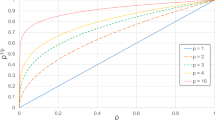Abstract
This paper presents a robust optimization design method based on Six Sigma quality control criteria to improve the design of a powertrain mounting system (PMS). The powertrain is modeled as a rigid body having six degrees of freedom (DOF) connected to a rigid base by four rubber mounts, and each mount is simplified as a three-dimensional spring-damper element in its local coordinate system (LCS). The calculation method based on energy decoupling is used to estimate the decoupling ratios of a PMS. The location and static stiffness of each mount and the orientations of the two anti-torsion mounts are selected as uncertain design variables, and the nominal values of these design variables are optimized to obtain a robust Six Sigma design for a PMS. The uncertain design variables are characterized by a perturbation or percent variation around their nominal values. The generalized reduced gradient (LSGRG2) optimization method is employed to solve the robust optimization problem, and a second-order Taylor series expansion is used to estimate the statistical properties of the performance constraints and objectives. The optimization results show that the robust design ensures good robustness or high reliability for the natural frequencies, decoupling ratios, and frequency separation constraints of a PMS.
Similar content being viewed by others
References
Bernard, J. E. and Starkey, J. M. (1983). Engine mount optimization. SAE Paper No. 830257.
Brach, R. M. (1997). Automotive powerplant isolation strategies. SAE Paper No. 971942.
Cho, S. (2000). Configuration and sizing optimization of powertrain mounting systems. Int. J. Vehicle Design 24,1, 34–37.
Demic, M. (1990). A contribution to the optimization of the position and the characteristics of passenger car powertrain mounts. Int. J. Vehicle Design 11,1, 87–103.
Geck, P. E. and Patton, R. D. (1984). Front wheel drive engine mount optimization. SAE Paper No. 840736.
Ishihama, M., Seto, K., Nagamatsu, A. and Doi, K. (1995). Control of engine roll and bounce vibration using hydraulic mounts. JSME Int. J. (Series C) 38,1, 29–35.
Johson, S. R. and Subhedar, J. W. (1979). Computer optimization of engine mounting systems. SAE Paper No. 790974.
Koch, P. N., Yang, R. J. and Gu, L. (2004). Design for six sigma through robust optimization. Structural Multidiscipline Optimization, 26, 235–248.
Qatu, M., Sirafi, M. and Johns, F. (2002). Robustness of powertrain mount system for noise, vibration and harshness at idle. Proc. Institution of Mechanical Engineers Part D, J. Automobile Engineering, 216, 805–810.
Shangguan, W. B. and Lu, Z. H. (2004). Experimental study and simulation of a hydraulic engine mount with fully coupled fluid structure interaction finite element analysis model. Computers & Structures 82,22, 1751–1771.
Sirafi, M. and Chang, Y. P. (2006). Robustness of mount systems for idle NVH, Part 1: Center of Gravity (CG) mounts. Int. J. Vehicle Noise and Vibration 2,4, 317–333.
Sirafi, M. and Qatu, M. (2003). Accurate modeling for powertrain and subframe models. SAE Paper No. 2003-01-1469.
Snyman, J. A., Heuns, P. S. and Vermeulen, P. J. (1995). Vibration isolation of a mounted engine through optimization. Mechanism and Machine Theory 30,1, 109–118.
Suh, M. W., Shim, M. B., Kim, J. M. and Hong, S. K. (2003). Multidisciplinary design optimization of engine mounts with consideration of the driveline. Proc. Institution of Mechanical Engineers Part D, J. Automobile Engineering, 217, 107–113.
Swanson, D. A., Wu, H. T. and Ashrafiuon, H. (1993). Optimization of aircraft engine suspension systems. J. Aircraft 30,6, 979–984.
Tao, J. S., Liu, G. R. and Lam, K. Y. (2000). Design optimization of marine engine mount system. J. Sound and Vibration 235,3, 477–494.
Yu, Y. H., Naganathan, N. G. and Dukkipati, R. V. (2001). A literature review of automotive engine mount systems. Mechanism and Machine Theory 36,1, 123–142.
Zhang, Y. Q. and Shangguan, W. B. (2006). A novel approach for low-frequency performance design of hydraulic engine mounts. Computers & Structures 84,7/8, 572–584.
Zavala, P. A. G., Pavanello, R. and Vaqueiro, J. (2000). Experimental and computational simulation approaches for engine mounting development and certification. SAE Paper No. 2000-01-3239.
Author information
Authors and Affiliations
Corresponding author
Rights and permissions
About this article
Cite this article
Wu, J., Shangguan, W.B. Robust optimization design method for powertrain mounting systems based on six sigma quality control criteria. Int.J Automot. Technol. 11, 651–658 (2010). https://doi.org/10.1007/s12239-010-0077-2
Received:
Revised:
Published:
Issue Date:
DOI: https://doi.org/10.1007/s12239-010-0077-2




